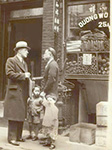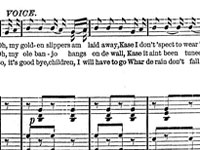 In 1790, federal marshals collected data for the first census, knocking by hand on each and every door. As directed by the U.S. Constitution, they counted the population based on specific criteria, including "males under 16 years, free White females, all other free persons (by sex and color), and slaves." There was no pre-printed form, however, so marshals submitted their returns, sometimes with additional information, in a variety of formats.
In 1790, federal marshals collected data for the first census, knocking by hand on each and every door. As directed by the U.S. Constitution, they counted the population based on specific criteria, including "males under 16 years, free White females, all other free persons (by sex and color), and slaves." There was no pre-printed form, however, so marshals submitted their returns, sometimes with additional information, in a variety of formats.
In 1810 and 1820, additional categories appeared, collecting information on "free White males and females under 10 years of age," as well as those "10 and under 16," "16 and under 26," "26 and under 45," and "45 years and upward." "Free colored persons" and slaves were now counted separately as were "all other persons, except Indians not taxed" and "foreigners not naturalized." Through the decades, the census continued to expand, including a growing number of questions on agriculture, manufacturing, living conditions, education, crime, mortality, and increasingly, race and ancestry.
The census has always had political implications, informing conscription, Congressional representation, and the collection and allocation of taxes. It has also always both reflected and shaped social divisions. Before 1960, census enumerators interviewed families in person and without consulting the individuals, selected which box to check for "race." Starting in 1960, largely for financial reasons, the Census Bureau mailed forms directly to households, thereby allowing individuals to select their own boxes. This led to a fundamental change in the way race was categorized and measured. In 2000, for the first time, individuals could select more than one box and about 6.8 million Americans did so, reflecting the complex nature of racial and ethnic categories today.
The 2010 census is designed to count all residents and will ask a small number of questions, such as name, sex, age, date of birth, race, ethnicity, relationship and housing tenure. The longer American Community Survey will collect socioeconomic data annually from a representative sample of the population.
For searchable (and map-able) databases of historical census data from 1790 to 1960, refer to the University of Virginia's United States Historical Census Data Browser. For more current information, try the official website of the U.S. Census Bureau..
 In 1790, federal marshals collected data for the first census, knocking by hand on each and every door. As directed by the U.S. Constitution, they counted the population based on specific criteria, including "males under 16 years, free White females, all other free persons (by sex and color), and slaves." There was no pre-printed form, however, so marshals submitted their returns, sometimes with additional information, in a variety of formats.
In 1790, federal marshals collected data for the first census, knocking by hand on each and every door. As directed by the U.S. Constitution, they counted the population based on specific criteria, including "males under 16 years, free White females, all other free persons (by sex and color), and slaves." There was no pre-printed form, however, so marshals submitted their returns, sometimes with additional information, in a variety of formats.
